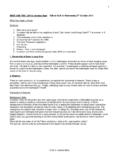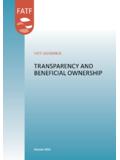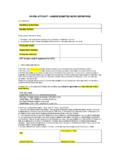Transcription of GUIDE TO STRUCTURING EMPLOYEE OWNERSHIP
1 GUIDE TO STRUCTURING EMPLOYEE OWNERSHIPBETTER BUSINESS TOGETHER2 EMPLOYEE OWNERSHIP AssociationGuide to STRUCTURING EMPLOYEE OwnershipGuide to STRUCTURING EMPLOYEE OwnershipCONTENTS 3. Foreword 4. Introduction and different forms of EMPLOYEE OWNERSHIP 6. When and how to introduce EMPLOYEE OWNERSHIP in your company 13. Do s and don ts of EMPLOYEE OWNERSHIP 14. Tax reliefs: how they work and when they can help 18. Implementation flowchart 19. Conclusion 20. Schedule: Tax reliefs in more detail3 EMPLOYEE OWNERSHIP AssociationGuide to STRUCTURING EMPLOYEE OwnershipFOREWORDE mployee OWNERSHIP is the model in which the share capital of a business is partly or entirely owned by its workforce. It is the fastest growing form of business OWNERSHIP in the popularity of EMPLOYEE OWNERSHIP is based on the growing evidence of its benefits. EMPLOYEE owned businesses are characterised by their higher productivity, greater levels of innovation and better resilience to economic turbulence.
2 They also tend to be very profitable. Over the last 15 years, for instance, shares in EMPLOYEE owned businesses have considerably outperformed those in the FTSE All-Share is a model that is straight forward to embrace and relatively simple to adopt whilst being very flexible to the individual needs of different businesses. If you have begun to think about introducing EMPLOYEE OWNERSHIP and are ready to consider the detail of implementation, this GUIDE is for you. It provides an invaluable tool for navigating through the process as well as giving solutions to every challenge you might face along the would like to thank Robert Postlethwaite for all his work in helping to produce this GUIDE and to his Firm, Postlethwaite Solicitors ( ) for their kind sponsorship of its production. I wish you well in your journey towards EMPLOYEE OWNERSHIP . I also look forward to welcoming you into the EOA in the future.
3 The vast majority of people who adopt EMPLOYEE OWNERSHIP in the UK join the EOA in order to do Hasdell Chief Executive EMPLOYEE OWNERSHIP Association4 EMPLOYEE OWNERSHIP AssociationGuide to STRUCTURING EMPLOYEE Ownership1. INTRODUCTION AND DIFFERENT FORMS OF EMPLOYEE OWNERSHIPNew to EMPLOYEE OWNERSHIP ?If you are new to EMPLOYEE OWNERSHIP and are not sure what it involves or what it looks like, we suggest that you take a look at our separate GUIDE EMPLOYEE OWNERSHIP : How To Get Started. You can download here: wp-content/uploads/The-How- Forms of EMPLOYEE ownershipAs the How to Get Started GUIDE describes, EMPLOYEE OWNERSHIP can take three main forms:- Direct (individual) share OWNERSHIP Each EMPLOYEE becomes a shareholder, personally holding a specified number of shares - Indirect OWNERSHIP Shares are held on behalf of employees as a whole in a trust, which must manage the shares in the best interests of the employees, in accordance with the terms of the trust deed and the law.
4 A trust is a legal arrangement under which assets are held by one person or a group of people (the trustee or trustees) but they are not permitted to derive any personal benefit from them; instead, the assets must be held for the benefit of individuals (beneficiaries). In an EMPLOYEE trust, the beneficiaries are the employees- Hybrid OWNERSHIP This combines OWNERSHIP of a strategic block of shares in a trust with individual share OWNERSHIP . The potential benefits of direct individual share OWNERSHIP are clear: every shareholder may receive a regular profit share through dividends, have voting rights and the possibility of selling their shares at a profit if they grow in value. The benefits of indirect EMPLOYEE OWNERSHIP include this being a simpler model to operate. It is often chosen by businesses intending that trust OWNERSHIP will benefit employees over the long term through the trust influencing the company s direction, as opposed to individuals profiting from dividends or a growth in share trust s holding of a particular percentage of a company will often be accompanied by an arrangement that the same percentage of the company s annual profits will be passed by the company directly to employees.
5 If the trust owns more than 50% of the company s shares, it may be possible for bonuses to a certain value to be paid income tax free. 5 EMPLOYEE OWNERSHIP AssociationGuide to STRUCTURING EMPLOYEE Ownership1. INTRODUCTION AND DIFFERENT FORMS OF EMPLOYEE OWNERSHIPW hich suits your companyGenerally, trust OWNERSHIP will be simpler both to set up and run. But this does not make it an automatic best choice for all companies, some of which may feel that individual OWNERSHIP is better suited to their circumstances. In the following table we set out each of the three forms of EMPLOYEE OWNERSHIP and a range of different circumstances and objectives which, depending on to what extent they are present in your company, may help you consider which might work best in your share ownershipIndirect (trust) ownershipHybrid ownershipCapital growth importantLow staff turnoverSmaller EMPLOYEE numbersEmployees likely to consider personal share OWNERSHIP more real than trust ownershipTax breaks for individual share OWNERSHIP make it more attractive and affordableHigher staff turnoverLarger EMPLOYEE numbersLong term investment/ OWNERSHIP is importantDesire to prevent (or make difficult) a takeoverEmployees may have difficulty funding share acquisitionLimited funds to buy back employees sharesIf bonuses/performance based rewards are important, the company is happy for these to be cash-based rather than involving shares.
6 Where the terms and level of the trust s OWNERSHIP allow it, the ability to pay bonuses free of income tax may be an added OWNERSHIP is preferred but you want some individual share OWNERSHIP to provide:- a modest degree of capital growth and/or- a direct feeling of ownershipYou want to limit the total number of shares in circulation, as this limits any need for the company to help pay for share buybacks from employees who wish to sell their shares (or are required to because they leave)6 EMPLOYEE OWNERSHIP AssociationGuide to STRUCTURING EMPLOYEE Ownership2. WHEN AND HOW TO DO ITWhenEmployee OWNERSHIP can be created either at the foundation of a business, or when it is already established. Creating EMPLOYEE OWNERSHIP as part of a new business will generally be simpler than doing so when the business is more established and has acquired value. Traditionally, new businesses tend to start off as a single individual, or as a joint initiative of a small group of entrepreneurs, sometimes with outside investors, who are all more or less involved in the management and/or financing of the venture.
7 However, it is increasingly common for new ventures to set aside a pool of shares to be allocated to employees. Where EMPLOYEE OWNERSHIP can be brought into being in a business s early years this will often avoid tax complications for employees and current shareholders, because share value is likely to be relatively low. However, many companies that create EMPLOYEE OWNERSHIP will do so later in time. This may be because they only feel it necessary to do so once their business has become established, or when the original founders wish to sell part, or their entire stake, and sale into EMPLOYEE OWNERSHIP is seen to be the most desirable route. There will be more to think about when selling shares in an established business into EMPLOYEE OWNERSHIP . In addition to considering what form EMPLOYEE OWNERSHIP will take, the current owners will also have to make decisions about how much of the company will be EMPLOYEE owned, what the price will be, how the transaction will be financed and their own tax situation.
8 It will also be important to gain the support of all current shareholders for the OWNERSHIP may also be created where a new business is formed to take over responsibility for delivering a public service (often called an EMPLOYEE -led/owned public service spin out). Here, many of the same issues will arise as where EMPLOYEE OWNERSHIP is to be built into any other new business. Additionally, there are likely to be legal and practical tasks associated with transferring responsibility for service delivery to the new first decision will be on whether you want individual, trust or the hybrid form of EMPLOYEE OWNERSHIP . What happens next is going to depend on which you have ownershipYou will need to think about how employees are going to acquire their shares. There are three main ways of doing so. Employees can, in the main:- be given shares- buy shares- be granted options to acquire shares in the futureWhere employees are given free shares, they will be subject to income tax (and possibly also National Insurance) on the value of the shares when they receive them, unless they do through a tax exempt arrangement.
9 In a company s early months of trading, its shares may have only a low value and so there may be no or minimal taxation consequences. However, shares in a more established company are more likely to have acquired a financial value, in which case you may want to consider how to avoid an award of free shares resulting in a tax liability. You could establish a Share Incentive Plan (SIP), which provides statutory tax relief in respect of awards of free 7 EMPLOYEE OWNERSHIP AssociationGuide to STRUCTURING EMPLOYEE Ownership2. WHEN AND HOW TO DO ITshares, subject to several conditions and requirements, including that EMPLOYEE will not generally be able to sell their shares within five years of acquiring them. Alternatively, employees could be granted options to receive their free shares in the future, which will defer the tax liability but may mean if the shares have grown in value by the time they are actually acquired that the liability increases (please see further later in this section).
10 If employees buy shares, this will not create a tax liability (so long as the price they pay is at least market value) but they will of course need to find the money to pay for them. It is often possible for them to pay by instalments, although if they do not pay interest on the outstanding amount they will generally have to pay income tax and NI on the unpaid interest. By allowing employees to acquire shares through a SIP through deduction from their weekly or monthly pay, they can be given full relief against income tax and NI on the purchase employees are granted options to acquire shares in the future, this will not create an immediate tax liability. However, when the EMPLOYEE buys their shares (by exercising their option) they will have to pay income tax and possibly NI on the difference between the amount they pay and the shares value at the time the option is exercised, unless an exemption is available.







